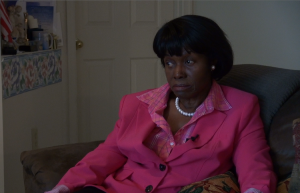
Marie Davenport participated in 1963’s March on Washington. But she worries economic conditions haven’t improved much for African Americans 50 years later.
WASHINGTON – Marie Davenport grew up the daughter of sharecroppers in rural Mississippi in the 1950s and moved north the summer after high school graduation to realize the American dream in a less segregated landscape than her native Mississippi.
“There was a migration of blacks from the South because the opportunities weren’t there. You were just limited in terms of what you could really do,” said Davenport, one of thousands of people who participated in the March on Washington on Aug. 28, 1963 and was on hand for Wednesday’s 50th anniversary march.
“It was the beginning of a new journey for me because my family in Mississippi, my grandmother, they were still farming,” she said. Davenport, who was 26 when she participated in the march, now lives in a Washington suburb.
Economic opportunity and fair wages were major underpinnings for the original March on Washington, which was originally titled “The March on Washington for Jobs and Freedom.”
But has the economic condition for African American women improved?
Economists aren’t sure.
“It depends on the measure you use,” Dr. Margaret Simms, an African American economist at the Urban Institute, said.
According to the Bureau of Labor Statistics Current Population Survey, black women were second only to black men in terms of rates of unemployment between 2007 and 2012 – a period of time that coincides with the recession, which disproportionately affected African American homeowners.
“Unemployment rates are higher and the gaps are larger for black men than for black women,” Simms recently wrote on her blog, MetroTrends.
The gap in employment between black and white women is startling.
As of August, 6.4 percent of black women with a bachelor’s degree or more were unemployed – compared with 3.9 percent of white women. For black women with less than a high school degree, 23.1 percent faced unemployment. That’s nearly double the number of white women with similar academic credentials facing unemployment –13.4 percent.
“If you compare white women and black women with a BA or higher, white women earn $100 more a week,” Simms said.
The reasons for these gaps are socioeconomic and date back to the civil rights era.
“African Americans live in different communities from whites,” Simms said. “They tend to be younger than white workers, on average, and so would have less experience.
“But we cannot discount lingering vestiges of discrimination – documented by study after study – that still affect hiring and promotion decisions.”
Still, black women have improved from the days where they had limited job opportunities.
When Davenport was looking for a job, she initially couldn’t seem to find a job in her dream profession of teaching. Instead, she became a cosmetologist – a position that was very risky for her as well because many white women were uncomfortable with a black woman handling their hair.
“What could you do?” she said. “I went to beauty school instead. From that time on, I worked.”
Simms said corporate America is still overwhelmingly white and male, but changes have slowly begun.
“In the private sector, you see women moving up more,” she said, pointing to the Lilly Ledbetter Fair Pay Act of 2009 that created an equal platform for those filing an equal-pay lawsuit, reducing the time for filing to 180 days after each paycheck.
But corporate America has almost no African American female representation – and that troubles black women like Davenport.
“The economic condition of black women is certainly better, but we’re not there yet,” Davenport said. “It’s not always about the rules. The attitudes of the people need to change. Black women… need to stand up together.”
Simms agreed from both an academic and personal standpoint.
“I think that there certainly has been progress since the time of the March on Washington in terms of the types of positions that African American women can achieve,” Simms said. “It’s opened up job opportunities.”
Nevertheless, the need for a March on Washington rings true today despite 50 years of social change and progress for women like Davenport and Simms.
“There’s still a need for change,” Davenport said. “There’s still prejudice, there’s still segregation, so yes, there’s still a need for change.”
